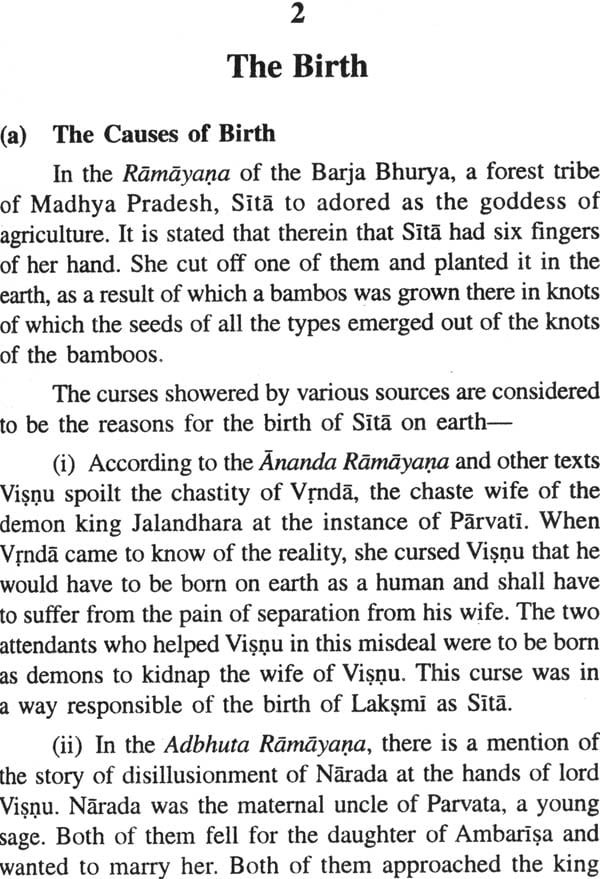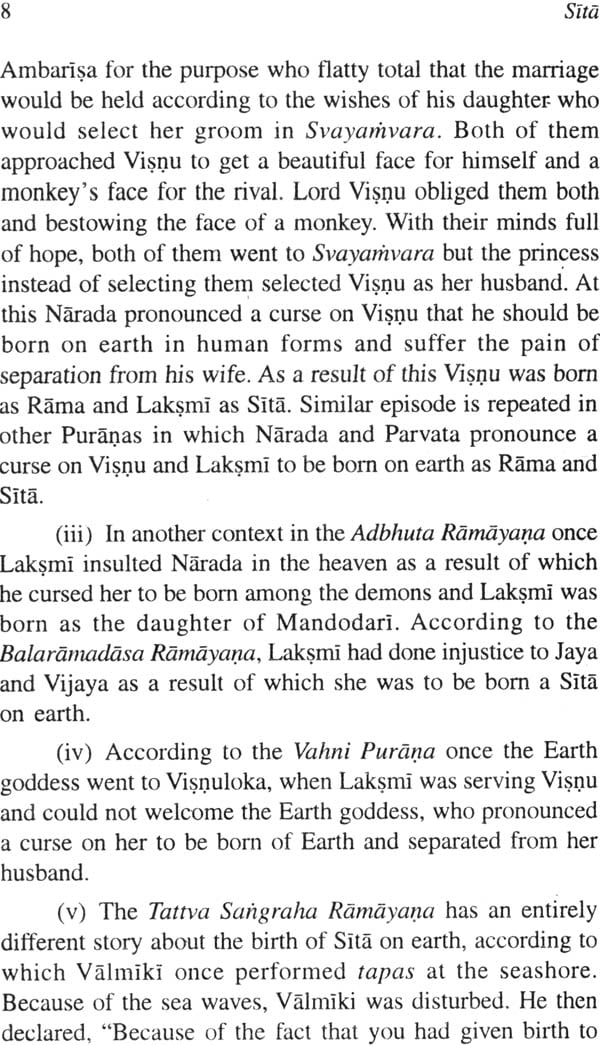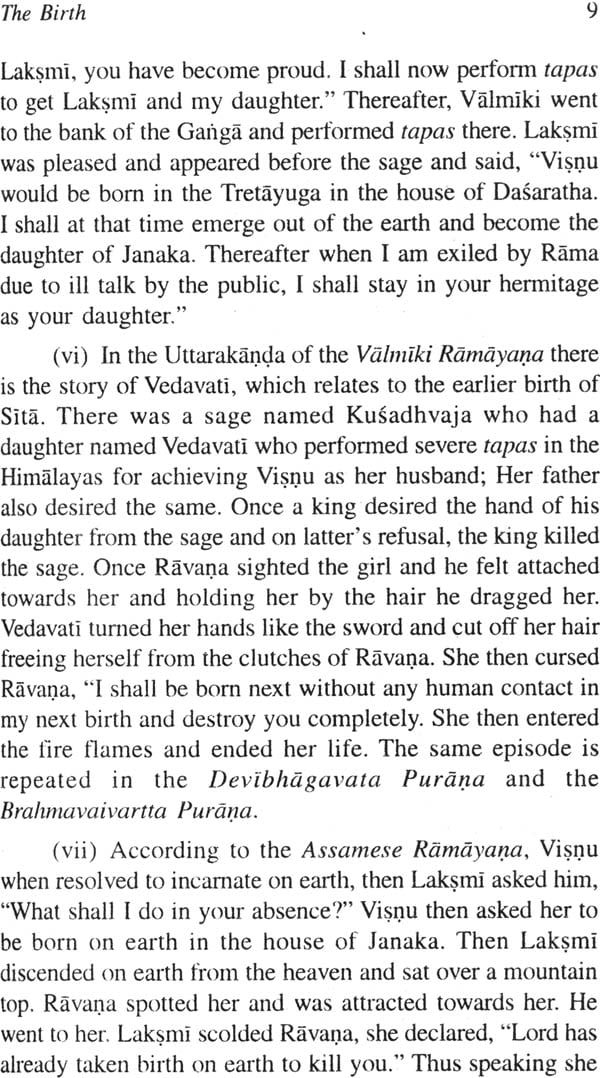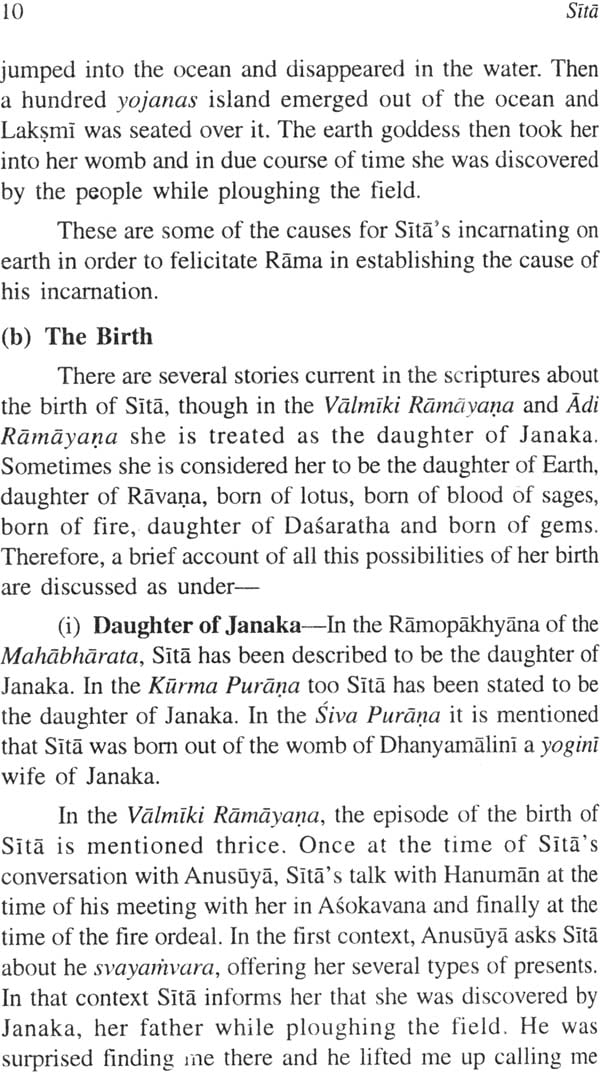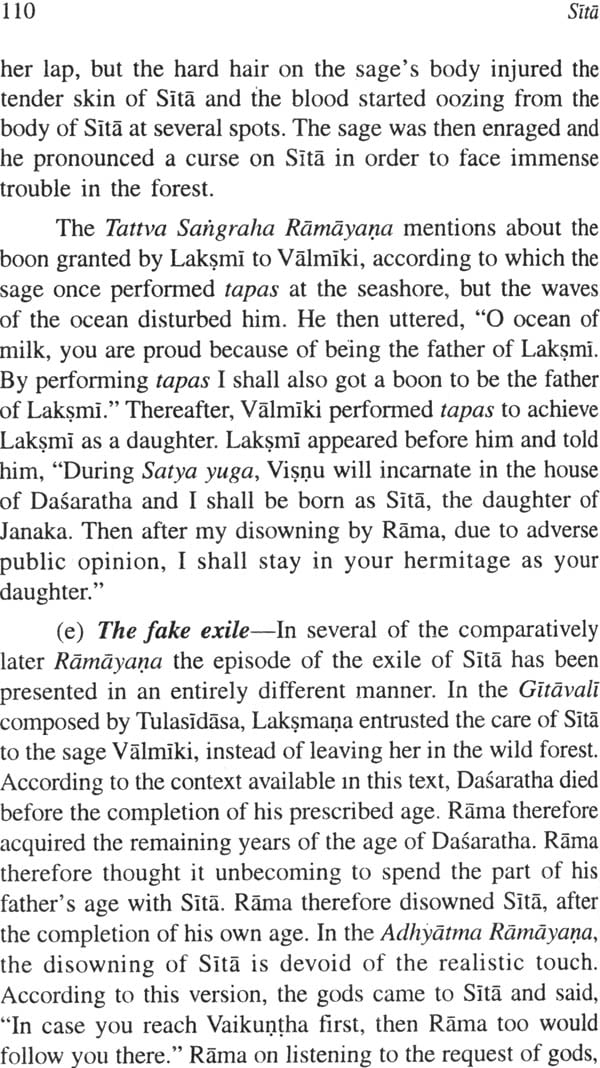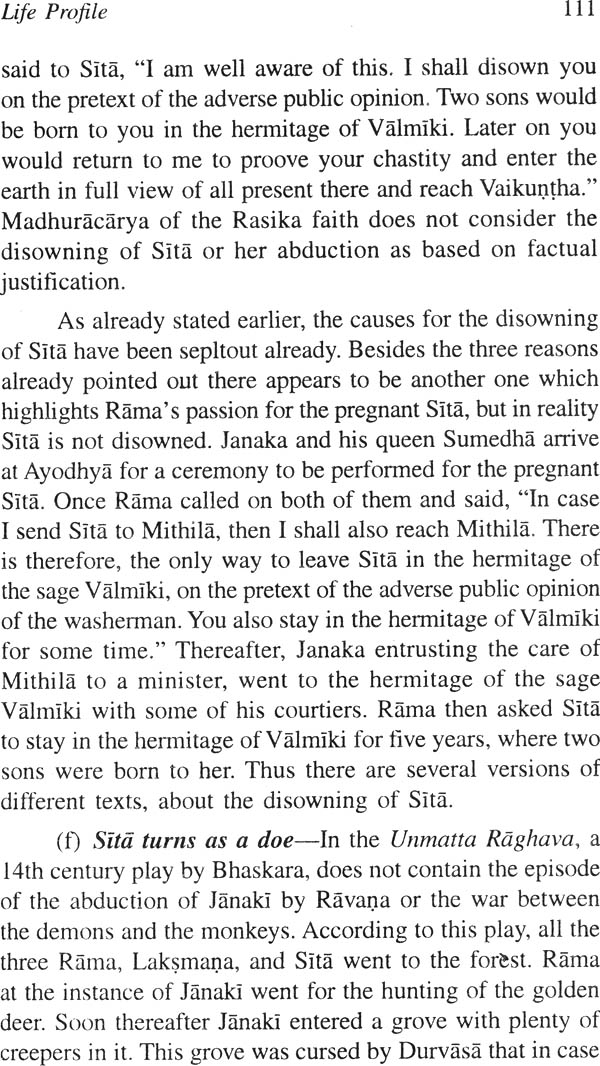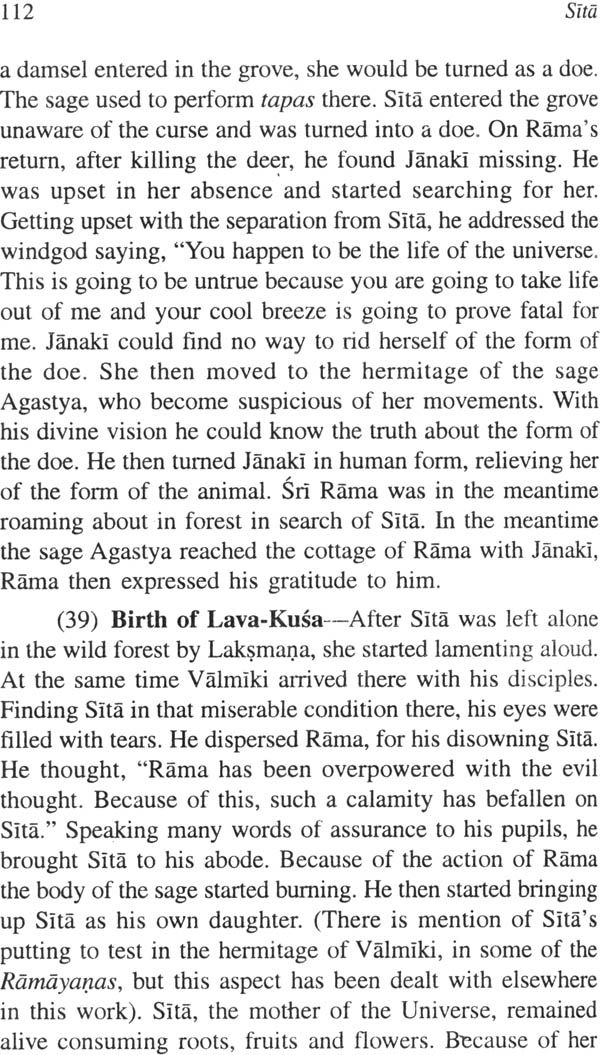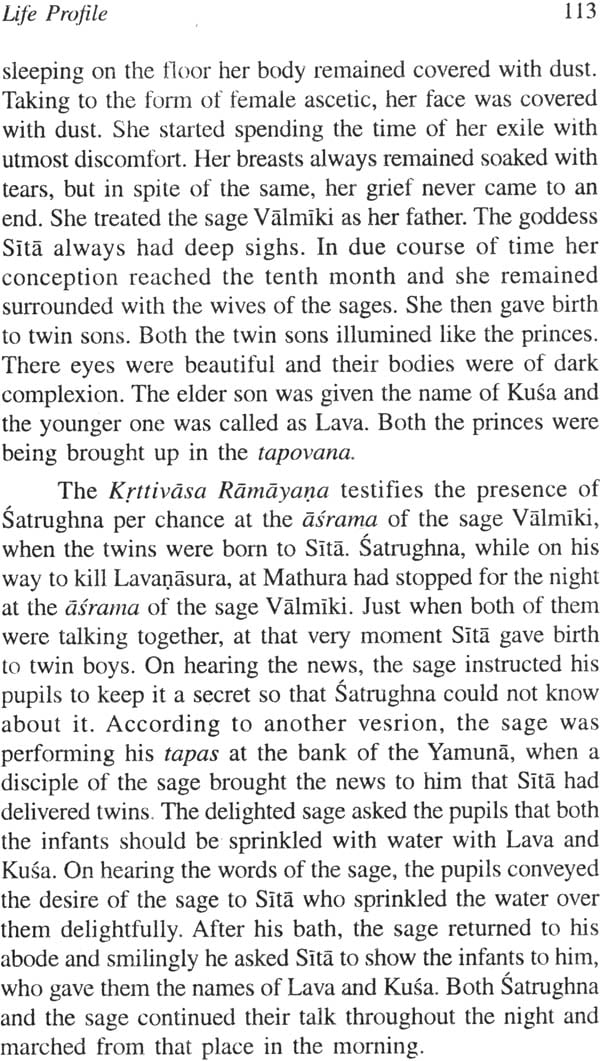
Sita (The Image of Chastity)
Book Specification
| Item Code: | IDK512 |
| Author: | Shantilal Nagar |
| Publisher: | B.R. Publishing Corporation |
| Language: | English |
| Edition: | 2006 |
| ISBN: | 9788176464888 |
| Pages: | 144 |
| Cover: | Hardcover |
| Other Details | 8.7" X 5.7" |
| Weight | 300 gm |
Book Description
About the Book
Sita in the epic Ramayana has been the heroine of the story. Various texts narrate different stories about her birth but the most prominent of them had been that she had been found by Janaka while ploughing the field, to appease the god of rains and was subsequently adopted by him as his daughter. In fact she had dominated the entire story of epic, and with her disappearing from the epic, the entire story becomes lusterless.
About the Author
Shantilal Nagar, a graduate of the Punjab University, served in the curatorial capacity in the Central Asian Antiquities Museum, New Delhi, the Archaeological Museum, Nalanda, and Archaeological Section of the Indian Museum, Calcutta for a number of years. He has to his credit the scientific documentation of over fifty thousand antiquities, in these museums, representing the rich cultural heritage of the country and comprising of sculptures, bronzes, terracottas, beads, seals and sealing, ancient Indian numismatics, wood work, miniatures and paintings, textiles and Pearce collection of gems, ranging from the earliest times to the late medieval period. He was awarded, in 1987, a fellowship, for his monograph on the temples of Himachal Pradesh, by the Indian Council of Historical Research, New Delhi. He has authored more than fifty books.
The Vedic Background
sita who had been so popular in the epics and the Puranas, is also found mentioned in the Vedic literature, though as a goddess of Agriculture.
During the early Vedic period mostly the gods of nature were adored. In other the forces of nature in their natural form were adored as the deities. These forces were divided into three distinct regions namely-the earth, the sky and the space or the heaven. In the Rgveda, Indra, Agni, Soma, Surya, Space, Wind, Usa, Varuna, Mitra, Parjanya and several such gods were adored. The region of operation of all of them was quite exclusive and Indra happened to be quite an important of all the gods.
Besides the above another set of gods were also conceived, whose field of operation was quite a limited one. Ksetrapati, Vastospati (the god of household), Sita and Urvara (productive land) had their own importance. In the religious conseciousness their place was insignificant, because the welfare of the Aryans lay with the first category of the gods. sita Ksetrapati and other such dieties related to the agriculture were possibly of lessor importane, because the upkeep and domesticating of the animals was considered to be more important than the irrigation. In the earliest part of the Rgveda (Mandalas 2-7) the passages relating to the farming and produce are used only once which relates to the tenth Mandala, That is the only stage in the Rgveda wherein divinity is conferred over Sita. This Sita is conceived as the goddess of farming and produce. Side by side with Sita, Savitri was also used at that stage for the same purpose. Two separate type of prayers were addressed to both of them. Two new types of prayers are addressed to Sita during the period of Grhyasutras.
Each one of the Suktas of the Rgveda eulogises one single god only, but in the Sukta dealing with Sita several other gods relating to the agricultural farming have also been included for prayers. The following passages are found in the fourth Mandala of the Rgveda dealing with the farming and crops etc.-
(i) Let us produce the welfare food for our cows and horses by the grace of Ksetrapati.
(ii) O Ksetrapati, as the cow provides milk, you also supply us the auspicious water which is like honey and ghee.
(iii) Let the Osadhis in the field be like honey. Let the rain of honey fall an us from the heaven and the sky. Let us take refuge with Ksetrapati, getting from the danger of enemies.
(iv) Let our vehicles like the bulls etc., remain comfortable. Let the farmers remain with comfort. They should plough the land with ease. The ropes of the ploughs should be bound tightly and the goal should be moved gracefully.
(v) O Sunasir, let both of you be pleased with our prayer. Let the land be irrigated with the water from your sky.
(vi) O fortunate one appear before us quite pleasently. O Sita, we offer our salutation to you, as a result of which you produce for us the beautiful fruits and riches.
(vii) Indra should accept Sita, Pusan should manage the same. The same Sita having been filled with water should produce the cereals for us.
(viii) The beautiful ploughs should move in the fields. The farmers should follow the ploughs quite comfortably. Let Parjanya irrigate the fields with water. O Sunasira, provide us all the comforts.
The above passages have their own importance because the contain the earliest prayer to sita. Similar types of prayer to Sita has been addressed in an other context in the Rgveda. The spirit of this Sukta has also been repeated in the three Grhya Sutras of the Rgveda.
The other prayers for Sita in the Vedic literature, forms part of the mantra known as Sira Yunjanti. This hymn is also found repeated in the Yajurveda and the Atharvaveda. In the Yajurveda, this hymn has been used for a purpose other than the farming which does not appear to be quite appropriate. In the Atharvaveda the hymns were compose to meet with the worldly requirements and with that end in view, they were distributed according to different classifications. Some of them dealt with removal of ailments, some for achieving good health, long life and, or for having enough of the domestic animals or for the subjugation of the enemies. But in the Sira Yanjanti hymns is one of the hymns for success in trade and commerce. The gods, according to this hymn are invoked for gaining various types of success in various fields of life. Sita has also been invoked in the last rites performed for the dead and the consigning of their mortal remains.
Except for the instances pointed out above, sita has been mentioned broadly speaking in the Vedic literature for the purpose of agriculture. It may be recalled here that Sita is not only the goddess of farming and fields, she is also invoked during the sacrifices with other gods. Indeed she enjoys a prominent position among the Vedic deities. Besides Sitayajna has been mentioned in Paraskara Grhyasutra besides other texts. Under this the farmers light the fire on the northern or eastern side comer of the field and make the offerings of ghee invoking, Indra, Sita etc. Thereafter, the offerings of cooked rice with milk is offered to Sita invoking her as the goddess of devotion and riches. Ultimately the offerings of Durba grass is also made to the Bhutas who protect Sita.
Though Sita, Rama, Dasaratha, Iksvaku and Laksmana are found mentioned in the Vedic literature besides the sages like Vasistha, Visvamitra, Ahalya, Gautama and others but the seeds of the story of Ramayana are hardly found therein, though there is a school of thought in the country and abroad which firmly believes in the Vedic origin of the Ramayana story. In this connection in the Mantra Ramayana Nilakantha of the fourteenth century has taken pains to establish the Vedic origin of the Ramayana and he has interpreted a large number of Vedic hymns to represents the episodes of the Ramayana. But whatever may be the case, the sanctity of Sita in the Vedic literature cannot be denied.
Sita indeed was the goddess of agriculture, produce and abundance of the same. In fact the association of Rama with Sita, the goddess of plough, fields and the agriculture produce, is quite natural because according to the ancient belief the king happened to be the lord of the earth, its agricultural produce and fertility. The co-relation between the fertility and the human vigour besides the powers of the ruler or the king has been adequately projected in the Vedic literature where the all powerful god Indra had to fight with the mighty Vrtrasura who had been a source of obstruction
| 1 | Introductory | 1-6 |
| The Vedic Background | ||
| 2 | The Birth | 7-27 |
| (a) The Causes for Birth, (b) The Birth-(i) Daughter of Janaka, (ii) Born out of Earth, (iii) Daughter of Ravana, (iv) Born out of Lotus, (v) Born out of Blood, (vi) Born of Gems, (vii) Born of a Fruit, (viii) Born of fire, (ix) Born of a Tree, (x) Daughter of Dasaratha, (xi) Born of Peahen's Egg, (xii) The Age, (xiii) The Childhood. | ||
| 3 | Life Profile | 28-126 |
| (1) An Ideal Wife, (2) Pindadana by Sita, (3) Disfiguring of Surpanakha, (4) Reasons for the Abduction of Sita, (5) The Abduction, (6) Maya Sita, (7) The Search-(a) Sati's Encounter, (b) Dropping of Ornaments, (8) Hanuman's meeting with Janaki, (9) Grief of Sita, (10) Trijata's Dream, (11) Janaki Laments, (12) The Performance of Trijata, (13) Handing over of the ring, (14) Hanuman narrates his story of Sita, (15) Dialogue between Sita and Hanuman, (16) Hanuman begs for food from Sita, (17) Sita meets Hanuman after destruction of Lanka, (18) Ravana frightens Sita with the illusory head of Rama, (19) sita found Rama and Laksmana bound in Nagapasa, (20) Sita Consoled by Trijata, (21) Ravana advised to return Sita to Rama-(a) By Hanuman, (b) By vibhisana, (c) By Nikasa and Malyavan, (d) By Vibhisana, (c) By Nikasa and Malyavan, (d) By Prahasta, (e) By Suka and Sarana, (d) By Mandodari, (22) Killing of fake Sita, (23) Ravana resolves to kill Sita (24) Hanuman conveys to Sita about the death of Ravana, (25) Mandodari's curse to Sita, (26), Demonesses cursed Janaki, (27) Sita's meeting with Rama, (28) The Fire Ordcal, (29) The fire god hands over Sita (30) Projection of Fire Ordeal in other literature, (31) Return to Ayodhya, (32) Distribution of gifts by Rama and Sita, (33) The Meals, (34) Laksmana has his Meals, (35) Rama's Conjugal Pleasure (36) Blemish about Sita, (37) Ravana's sketch, (38) The exile of Sita-(i) Direct Reasons, (ii) The episode of the washerman, (iii) The sketch of Ravana. (iv) The Indirect Evidence, (v) The fake exile, (vi) Sita turns as a doe, (39) Birth of Lava-Kusa, (40) Golden images of Sita, (41) Sita's meeting with Hanuman and Jambavan, (42) Sita's entry into the Earth, (43) Opinions on Sita's entry into Patala. | ||
| 4 | The Episode of Sahasramukha Ravana | 127-138 |
| 5 | Other Aspects | 139-143 |
| (i) Ayonija, (ii) Incarnation of Laksmi, (iii) Strong willed, (iv) Morals and Ethics. | ||
| Arati Sri Janakiji Ki | 144 |
